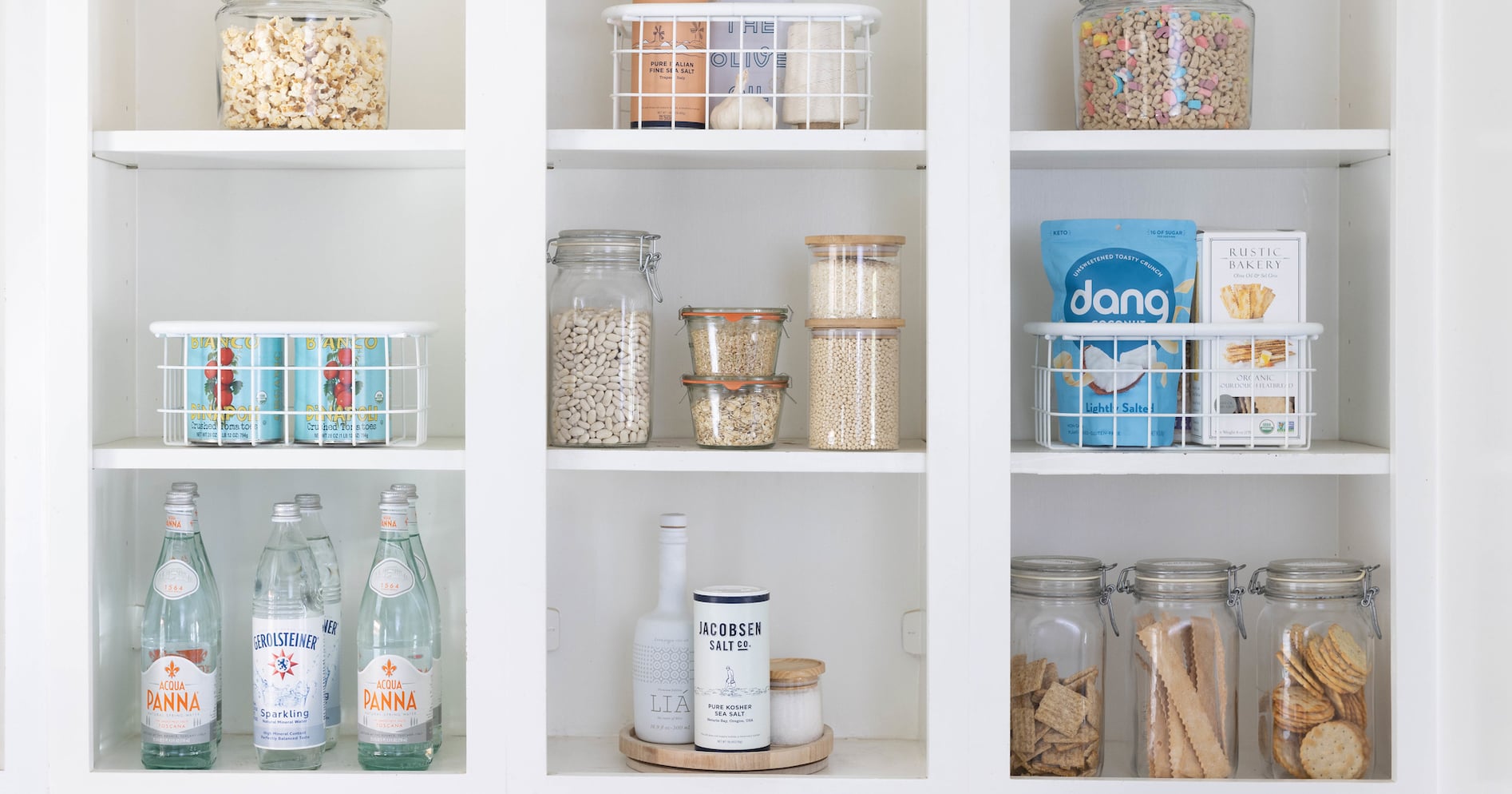Great news! It is totally possible to get in on the decanting trend without buying a heap of plastic containers, or taking time off from work to delicately funnel cinnamon from one tiny jar into another. As a busy working mom and a professional organizing expert (who has done her share of decanting), I’ve got some fool-proof tips to simplify the process and keep it sustainable and looking sharp.
What Is Decanting, Anyway?
You may be conjuring images of red wine resting in oddly shaped glass vessels, and you’re not wrong, but it’s actually broader than that. The term “decanting” is really just a fancy word that means taking products out of their original packaging and putting them into more elevated (typically clear) containers, like jars or canisters.
Why Decant?
Surprise! Decanting makes your pantry look dialed in, but there’s actually way more to decanting than just aesthetics. Here are a few of the top perks and benefits.
- It’s space-maximizing; part of the decanting process involves ditching all excess packaging. Bye, bulky cardboard boxes and plastic inserts.
- It keeps the pests and critters out. (Ew, but also, yay.)
- It eliminates food waste. Airtight containers keep food fresher longer, and when you’ve got cheese to eat, stale crackers are a big bummer.
- It enables you to take a quick inventory of what you have, as clear containers make it easy to see when it’s time to restock with a quick glance. No more finding out the hard way you live with someone who puts the box back with only three Cheerios left in it.
- It reduces visual clutter and instantly elevates the look and feel of your space.
Decanting Made Easy
Are you decanting curious? Here’s a step-by-step guide to break down the process so you can customize it for your specific needs and preferences.
Decide What’s Actually Worth Decanting
While it’s not uncommon for people to get carried away once they catch the decanting bug, there is really no need to decant and label every single item in your home or pantry. Here’s a quick rundown of some basic decanting dos and don’t bothers.
- Baking Staples: A big emphatic “yes” to decanting baking staples! Flours, sugars, cornstarch, baking soda and powder, and chocolate chips stay super fresh for months on end when stored in airtight glass containers. Less frequently used or specialty items, like sprinkles, frosting, and extracts, can be centralized and stored in a bin to keep things tidy – no need to decant.
- Snacks: It pays to decant items like nuts, dried fruit, crackers, and pretzels that can get stale quickly once opened. Take a pass on decanting boxes of snacks or cookies, oversized bags of chips (hard to fit into a jar) and individually wrapped snacks like bars and fruit rolls. Instead, corral all of your treats and snacks into an oversized bin or basket.
- Pasta and Grains: This one’s a dealer’s choice. If your family tends to go through an entire box of rice or pasta in one meal, decanting might feel silly and unnecessary. Instead, you can do like the organizer’s do and set up a “pasta” bin as well as a “rice and grains” bin stocked with your favorite staples. If you tend to only have a few boxes of pasta and grains that you consume slowly, you can use a portion or two and airtight jars will ensure that the rest stays fresh.
- Canned Goods: Do not even waste a second thinking about decanting items like tomato sauce, beans, soups, condiments, or tinned fish that are already safely stored in jars, tins, or canisters. Life is too short!
- One-and-Done Items: Baking mixes, pancake or waffle mixes, and boxed mac and cheese are just fine as they are. Line them up neatly in your pantry or pop them in a basket and call it a day.
- Spices: Most spices are already packaged in air-tight jars, so there’s no need to get your funnel out unless you prefer to buy spices from the bulk bins (please treat those bulk spices with respect and get them a nice glass home so they stay fresh). There are also companies, like Evermill, that sell beautiful spice jar sets with refill packs available, so you can skip the time-consuming decanting shenanigans (and mess, since getting every grain in the jar is statistically impossible), while still achieving the eye-pleasing aesthetic of matching vessels.
Shop Your Home First
While it may be tempting to take The Container Store by storm, your home is probably already stocked with serviceable vessels that are fully functional for your decanting needs. Jam jars, pasta sauce jars, and mason jars all work perfectly well for storing your staples and cost you zero dollars. Use what you have, buy only what you really need.
Opt For Glass Over Plastic
Glass is not only more food safe (no thanks to toxic chemicals touching my food) but also more durable – and dare I say, chic?
Label Like a Pro
Since decanting requires tossing the original product packaging, you can either cut out product info and insert it into your jar, or simply use a chalk pen or wine writer pen to jot down crucial info like expiration dates and cooking instructions.
For labels, keep your categories broad. Just because you happen to have a bag full of chocolate-covered quinoa bites, does not mean they require their own label. Instead of “brazil nuts” or “dried cranberries,” try “nuts” and “dried fruits.”
In my home, we have six large airtight jars labeled “snacks,” and two for “cereal,” which sometimes even holds cereal adjacent items like granola. By keeping your label categories more general you can always update and swap out your staples without having to constantly be updating your jars or labels.
Back It Up
Probably the most common question I receive about decanting is what to do with the leftover product that doesn’t fit in the container. If space permits, set up a “back-up bin” for yourself stocked with all the bits and bobs that didn’t fit into your containers. Otherwise, you can just tuck the excess (sealed tight to preserve freshness) right behind your jars and restock when necessary.
Shop the Bulk Bins
The irony of buying packaged goods only to pour them into clear glass jars is not lost on me, which is why I suggest shopping from your local bulk bins whenever possible. Many grocers, and even some major supermarkets, have bulk bin sections where you can buy staples by the pound – minus all of the plastic and cardboard packaging waste – and it’s usually cheaper too. You can use compostable or cloth bags to restock and then transfer everything into your jars once you get home.
By selectively decanting, repurposing containers, and opting out of the plastic haul, you can create an organized, stylish pantry that saves you money and reduces environmental impact. File that as a win-win.
Shira Gill is a globally recognized home-organizing expert and author with a minimalist philosophy. She’s inspired thousands of people to clear clutter from their homes and lives through a process she developed that applies to anyone, regardless of budget, space, or lifestyle. Shira is the bestselling author of “Minimalista” and “Organized Living” and has been featured by 100+ media outlets.




